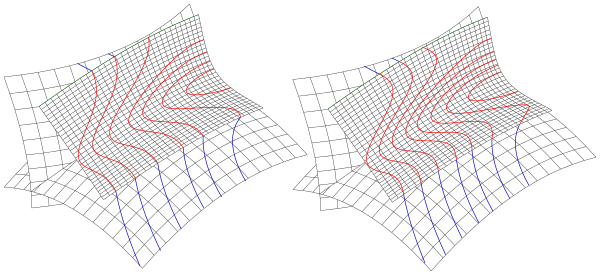Isophotes
In geometry, an isophoto is a curve on an illuminated surface that connects points of equal brightness. It is assumed that the surface is illuminated with parallel light and the brightness is measured in a surface point with the following scalar product:
It is the unit normal vector at the surface point and the unit light vector. Is , d. H. the direction of light perpendicular to the normal is a point of the surface outline with parallel projection in the direction . Brightness 1 means that the light falls at point P perpendicularly onto the surface. A plane has no isophotes because every point on the plane has the same brightness.
In astronomy , an isophot is a curve on a photograph that connects points of equal brightness.
Application with example
Isophotes are used in CAD as test curves to visually assess the quality of surface transitions. Because with a sufficiently differentiable surface (implicit or parameterized) the normal vector of the surface depends on the first derivatives. The differentiability of the isophotes and thus their geometric continuity is reduced by 1 compared to the area. If only the tangential planes are continuous (i.e. -continuous) at one point on the surface , the isophote has a kink at this point (i.e. it is only -continuous).
In the following example (see picture), two intersecting tensor product Bezier surfaces are rounded using a transition surface . On the left the transition surface only has -contact with the Bezier surfaces, on the right -contact. This difference cannot be seen without the isophotes. Only the isophotes show the difference: on the left the isophots have kinks, on the right they are smooth.
Determination of points of an isophoto
For an implicit surface
If the area is implicitly given by an equation , then the isophotic condition reads
In order to determine points of the isophotes belonging to a given one, one has to find solutions to the non-linear system of equations
determine. This system can be viewed as the intersection of two implicit surfaces and with the tracking algorithm of Bajaj et al. (see literature) calculate a sufficient number of points.
For parameterized areas
If the area is parameterized by given, then the isophotic condition reads
This equation can be converted into the equation
reshape. This equation describes an implicit curve in the st plane, for which one can determine a sufficient number of points with a tracking algorithm (see implicit curve ) and then calculate them with area points .
See also
literature
- J. Hoschek, D. Lasser: Fundamentals of geometric data processing , Teubner-Verlag, Stuttgart, 1989, ISBN 3-519-02962-6 , p. 31.
- Z. Sun, S. Shan, H. Sang et al .: Biometric Recognition , Springer, 2014, ISBN 978-3-319-12483-4 , p. 158.
- CL Bajaj, CM Hoffmann, RE Lynch, JEH Hopcroft: Tracing Surface Intersections , (1988) Comp. Aided Geom. Design 5, pp. 285-307.
- ^ J. Binney, M. Merrifield: Galactic Astronomy , Princeton University Press, 1998, ISBN 0-691-00402-1 , p. 178.


















